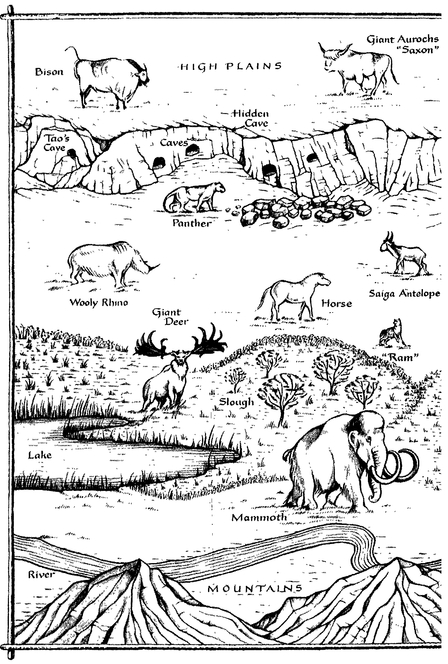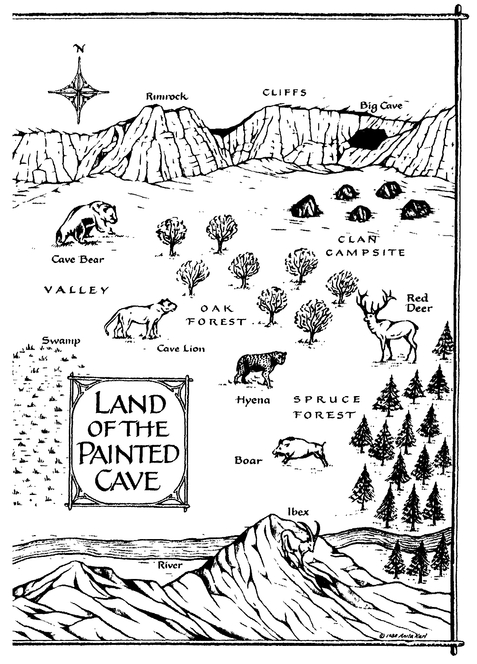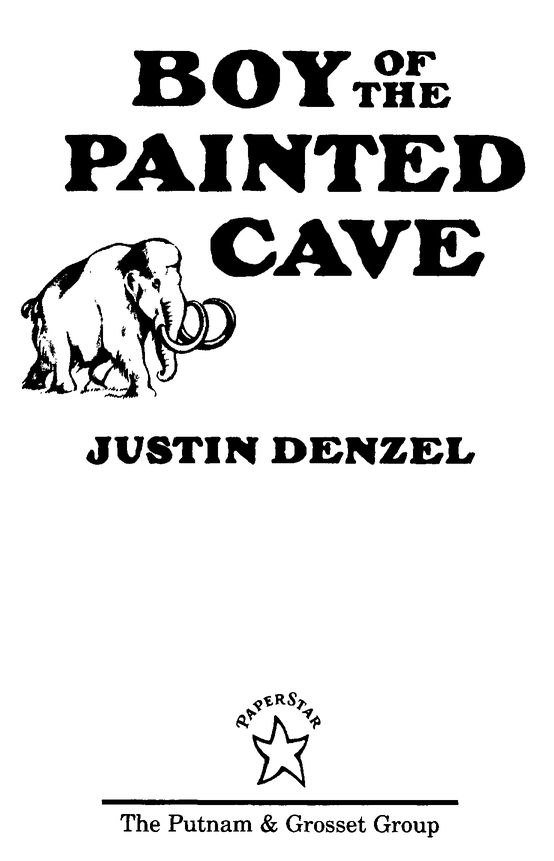The Boy of the Painted Cave
Read The Boy of the Painted Cave Online
Authors: Justin Denzel

Table of Contents
Â
Â
S
tumbling, lurching through the forest, Tao heard their pounding feet as the hunters picked up the trail. Without looking back, Tao hurdled over the ground, dodging between the trees and bushes. The wolf dog followed close behind as Tao ran into the night. Branches whipped across his face, tree roots caught at his feet, holding him back. But if he could run fast enough, long enough, he knew he would outrun the hunters and save Ram.
tumbling, lurching through the forest, Tao heard their pounding feet as the hunters picked up the trail. Without looking back, Tao hurdled over the ground, dodging between the trees and bushes. The wolf dog followed close behind as Tao ran into the night. Branches whipped across his face, tree roots caught at his feet, holding him back. But if he could run fast enough, long enough, he knew he would outrun the hunters and save Ram.
Breathing hard, he pushed his way through the underbrush, listening to the grunts and shouts of the angry men as they came after him. He ran faster and faster, twisting and turning through the trees and brush, trying to throw them off the track....



â I owe a debt of gratitude to the scientists, historians and photographers who, interested in the prehistoric world of Altamira and other southern European cave communities, painstakingly collected specimens and other research which resulted in a body of work that helped re-create that ancient world.
I have received help from many people but none more so than my editor, Patricia Lee Gauch, at Philomel Books. She spent long hours carefully going over each revision, suggesting vital changes and additions, deleting superfluous prose, weeding out clichés, refusing to settle for anything but the very best.
I am also indebted to my son and daughter-in-law, Ken and Elsie Denzel, who initiated me into the world of word processing, making the difficult task of revision almost a pleasure.
Finally I wish to thank Josephine, my wife, who spent many evenings going over the rough drafts, correcting my wayward spelling and unique style of punctuation. Without her patient efforts and moral support this book may not have been written.
Copyright
©
1988 by Justin Denzel.
©
1988 by Justin Denzel.
All rights reserved. This book, or parts thereof, may not be reproduced in any
form without permission in writing from the publisher.
A PaperStar Book, published in 1996 by The Putnam &
Grosset Group, 200 Madison Avenue, New York, NY 10016.
PaperStar is a registered trademark of The Putnam Berkley
Group, Inc. The PaperStar logo is a trademark of The Putnam
Berkley Group, Inc. Originally published in 1988 by Philomel
Books, New York. Published simultaneously in Canada.
Map illustrated by Anita Karl.
form without permission in writing from the publisher.
A PaperStar Book, published in 1996 by The Putnam &
Grosset Group, 200 Madison Avenue, New York, NY 10016.
PaperStar is a registered trademark of The Putnam Berkley
Group, Inc. The PaperStar logo is a trademark of The Putnam
Berkley Group, Inc. Originally published in 1988 by Philomel
Books, New York. Published simultaneously in Canada.
Map illustrated by Anita Karl.
Library of Congress Cataloging-in-Publication Data
Denzel, Justin F. Boy of the painted cave / by Justin Denzel.
p. cm. Summary: Forbidden to make images, fourteen-year-old
Tao, the boy with the bad foot, yearns to be a cave
painter, recording the figures of the mammals, rhinos, bison,
and other animals of his prehistoric times.
[1. Cave drawings
â
Fiction. 2. Man, Prehistoric
â
Fiction.]
I. Title. PZ7.D4377Cav 1988 [Fic]-dc19
87-36609 CIP AC
Denzel, Justin F. Boy of the painted cave / by Justin Denzel.
p. cm. Summary: Forbidden to make images, fourteen-year-old
Tao, the boy with the bad foot, yearns to be a cave
painter, recording the figures of the mammals, rhinos, bison,
and other animals of his prehistoric times.
[1. Cave drawings
â
Fiction. 2. Man, Prehistoric
â
Fiction.]
I. Title. PZ7.D4377Cav 1988 [Fic]-dc19
87-36609 CIP AC
eISBN : 978-1-101-07793-1
AUTHOR'S NOTE
Eighteen to twenty thousand years ago in the Dordogne valley of Southern France and around the foot-hills of the Pyrenees mountains, in Spain, there lived a Stone Age people who hunted the ancient beasts, the mammoths, the horses and woolly rhinos, the giant oxen and bison.
All over the world other people did much the same thing. But only here, in this small corner of Europe, did there arise a group of superb artists who adorned the walls of their caves with beautiful paintings of those magnificent animals.
Most of the primitive beasts are gone now, many of them extinct, a few domesticated and kept alive by man. But their colorful images live on, in the hidden caverns of the early cave painters.
This is the story of a young cave boy who dreamed of becoming such a cave painter. It tells of his fascination with the wild creatures around him and of his fight against superstition and taboos.
It tells of a world that has long since gone, a world that we will never see again.
This book is for my
grandchildren
Megan, Stephanie and Christopher
with much love.
grandchildren
Megan, Stephanie and Christopher
with much love.
ONE
T
ao looked out across the valley with its endless waves of yellow grass rippling under the late afternoon sun. He could see the small band of hunters walking ahead, turning over logs and stones, searching for ground squirrels, moles and grubs.
ao looked out across the valley with its endless waves of yellow grass rippling under the late afternoon sun. He could see the small band of hunters walking ahead, turning over logs and stones, searching for ground squirrels, moles and grubs.
Dirt matted their dark beards, burrs and stickers clung to their bearskin robes. They had been out three days, but the hunting was not good. Now they were returning home, tired, almost empty-handed.
The boy watched as the hunters disappeared over the brow of the hill. All day Tao had waited for this moment. With a rabbit in his hand and a leather pouch filled with moles and field mice dangling from his belt, he quickly hobbled over to the foot of a high embankment, where a smooth expanse of white sand had been washed down by the melting snows.
He looked around once again, took a deep breath and placed the rabbit on the ground. Then, with the point of his spear, he began tracing the shape of the rabbit in the sand.
He worked hurriedly, starting with the head, running the spear around the ears and along the back and stubby tail. When he came to the legs, his hand slipped, causing the spear to gouge a hole in the sand. He broke off a nearby willow branch and brushed away the drawing, then started over again. This time he worked carefully, guiding the spear along the natural curves of the animal's body. When it was finished, he stepped back, studying it for a moment. He shook his head. No, it did not look like a rabbit. It was too stiff, not real.
He felt a flush of anger and he shoved the rabbit aside. He looked over his shoulder again to be sure he was alone, then knelt down on the sand. With the fingers of his right hand he began to draw a picture of a bear. This he was sure he could do. Working from memory, he drew the huge head with its open mouth, showing the row of sharp teeth, the small round ears and the short snout.
As he worked, a warm feeling welled up in him. He forgot the hunters and the rabbit. He thought only of the big brown bears he had seen digging for roots in the marsh grass or scooping salmon out of the icy creeks down in the valley. He remembered their strong shoulders and shaggy brown coats, and for a moment the image became a living beast flowing from his mind, through his hand, directly onto the sand.
He finished his drawing by sketching in the high-arched back and sturdy legs. Then he stood up, brushing the sand from his knees. He looked down at the drawing, smiling broadly. It was good, he thought, the best he had ever done. Yet with time and practice he knew he could do better.
He did not remember when he first began making pictures. It must have been many summers ago when he lived with Kala. At first she was frightened of this. It was taboo and she tried to stop him. Then she let him go. But he could draw only on the dirt floor within the skin hut, where he would not be seen.
Suddenly his thoughts were interrupted by a soft rustling sound. With a shuffling of his deerskin boots he stamped out the picture and dropped quietly into a patch of tall grass. He waited, his heart pounding. He knew he could be severely punished, even banished, if he were caught making images. Except for a chosen few it was a strong taboo and against the secret rites of the clan.
Yet he longed to be an image maker, to be a cave painter like old Graybeard. He knew it was a foolish hope, for he was born of no shaman, he was the son of no chief or leader. He was only Tao, the boy with the bad foot. He did not even know his own father. His mother had died long before he could remember, and there was no elder to help him. Because of this, and because of his bad foot, he knew he could never become a Chosen One.
Whenever he saw the bison out on the plains, or the giant aurochs and cave lions, he wanted to paint their pictures on the walls of the Secret Cavern, a magic place, far back in Big Cave, where only the Chosen Ones could go.
Often, at night, he lay in front of Kala's hut listening to the crackling fire and looking up at the sky. He saw pictures of deer and horses amongst the stars. By day the billowing clouds became herds of antelope or the lumbering shapes of the mountains-that-walk, the mammoths.
Always during the hunts, he lagged behind the other hunters to watch the giant vultures tracing lazy circles beneath the clouds or to catch a glimpse of a woolly rhino outlined against the horizon. Sometimes seeing these things made him light-headed, almost bursting with joy, and he wanted others to see them as he did.
He knew that Garth and the other hunters did not understand this. Even Volt, the leader, looked upon him as an idler and a dreamer, unworthy of respect or manhood. He liked Garth best of all, because sometimes the big black-bearded man tried to help him. But when the other hunters came by, Garth often turned away and had other things to do.
Once again Tao heard the soft rustling sound in the grass. He waited, afraid to move. Then slowly he crept toward the sound, searching through the grass until he found a trail of pugmarks going around in circles. He gripped his spear tighter and fingered the leather pouch hanging from his belt. He was sure the scent of the dead mice had attracted a hungry animal and he had an uneasy feeling that he was being watched.
He waited silently, listening. Off in the distance he heard the harsh, scolding caw of a raven. That was all. He started walking again, along the foot of the cliffs, heading back for camp. He had only gone a few paces when the rustling noise came again.
Other books
Charlie Joe Jackson's Guide to Planet Girl by Tommy Greenwald
Two Masters for Alex by Claire Thompson
Watch Me by Brenda Novak
Connecting by Wendy Corsi Staub
Vincalis the Agitator by Holly Lisle
The Falling of Katja: an Erotic Romance (Anam Céile Chronicles) by Scarlett, Rosalind
With My Dog Eyes: A Novel by Hilda Hilst
The Eyes of Kid Midas by Neal Shusterman
Moscow Rules by Daniel Silva
Campaign for Love by Annabelle Stevens, Sorcha MacMurrough